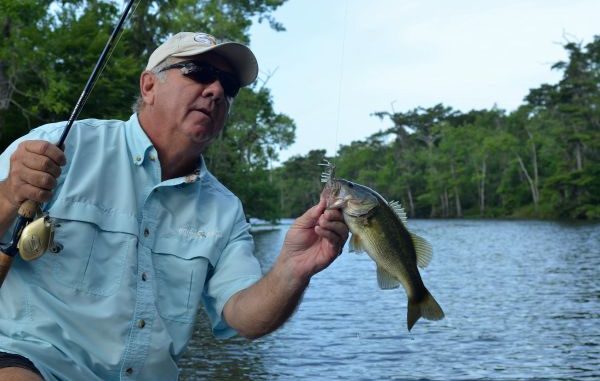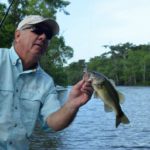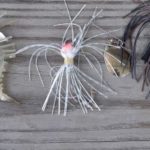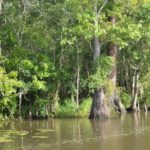
The Sabine River isn’t very well known except to locals, but these anglers know it provides some great bass fishing.
In the corner of his eye, Lake Charles’ Ken Chaumont spied what he was looking for. On a weedy point on the Louisiana side of the Sabine River across from Orange, Texas, balls of “rain shad,” as he called them, were erupting from the water.
“Ohhhh, we are going to get into them now,” said the 58-year-old angler and veteran lure designer with Egret Baits.
Picking up his rod, Chaumont quickly cast a pearly white, 3 ¼-inch plastic VuDu shrimp within the boiling fray on the eddy side of the point. He worked the shrimp as he would a swim bait, moving it slowly without a popping cork, when suddenly he felt the tap and set the hook.
“It’s a small bass, and there should be plenty more here,” he said.
Sure enough, cast after cast resulted in four 10- to 12- inch fish from that point.
“Lots of numbers,” Chaumont said. “We have some tidal movement, and as you can see the baitfish are here.”
The bite slowed after the fourth fish, so Chaumont backed his Pathfinder Fusion bay boat off the point and picking up another rod. He maneuvered back upcurrent while tying on a ¼-ounce, white-skirted Stanley Speed Bump spinnerbait that featured a small Colorado thumper blade.
He cast the lure into the tidal waters, and once again the line started running.
He pulled the fish in, and it was tad-larger specimen at 15 inches.
“Now then, this is exactly what I call the standard length of the bass you catch here in the fall,” Chaumont said. “But you’ll catch one keeper (14 inches and over) out of every four to five bass. The rest of them will be under the limit.”
“My largest taken in this system was a 6-pounder some years ago. But I can tell you that’s an extremely rare bass weight on the Sabine.”
Chaumont is no stranger to the Sabine River; he has fished the area for more than 40 years with friends and family. He also enjoyed the Calcasieu River for 52 years as its banks were home to his family’s camp in Indian Village.
“The Calcasieu may offer better bass quality and size,” Chaumont said. “But the Sabine has a much greater bass population.”
The Sabine River located on the Louisiana/Texas border was placed in the national spotlight during the first stop of the 2013 Bassmaster Elite series, when Texas’ Todd Faircloth won the event with 49.6 pounds of bass taken near Texas’ Taylor Bayou — reachable waters from the launch site in Orange.
Many of the Elite pros found the Sabine River itself very tough in March — with loads of small, non-keeper bass reported.
The fact of the matter, however, is that prior to this event the Sabine River was also an unknown to the vast majority of Louisiana bass anglers.
The Sabine River estuary offers bass anglers three major types of habitat to fish: traditional sandbar river habitat in its northern and midwestern sections; cypress/tupelo swamp habitat complete with cypress knees, sloughs and winding bayous; and marshlike areas found just before its into Sabine Lake south of Interstate 10.
On the southern end just north of Orange’s public boat landing, Chaumont motored to points, drains, marsh cuts, old bridge remnants and abandoned dock pilings.
In these areas, he caught small bass and a few keepers white Stanley Speed Bump spinnerbaits and pearly white VuDu shrimp.
“You want to work current,” he said. “So if the river is dead, and there is no current whatsoever, you’re looking at tough fishing. This southern part is tide-driven off the Sabine Lake and the Gulf of Mexico.”
Water movement is the key to success.
“You have two major influences here: the water coming down the river from the north, and your tides moving in and out on the south end,” Chaumont explained. “So you have to try and coordinate a little bit.
“I like to fish a falling tide, and you’ll see the cuts bleed around the points and the eddies forming around the old pilings and abandoned dock structures. So if you pull up to a piling or to a stump, you’ll find bass concentrated in numbers on the downside of the eddy created by the resistance of the structure. These fish will hold and wait for bait to swim by, and then charge out and hit the lures.”
And on the southern end of the river, shrimp and schools of shad are prime bass prey.
“Watch for your balls of shad, as they’ll look like little balls of bait swimming,” he described. “You’ll see them explode on top and the ball break apart on the surface.
“A spinnerbait with a silver blade on it and a shad-colored crankbait will work well; cast them in there and rip them to those shrimp and shad balls.”
However, it’s more involved than just casting and reeling the lure in.
“You don’t want to just plow your baits through it,” Chaumont said. “You want the lure to run up into the shad, and then let the bait fall through the ball.
“Slowly pick it up, and bass will charge it and hit it.”
Chaumont also uses a spinnerbait technique he termed as the “wake and break” to mimic the erupting balls of shad on the waters.
“You want to take that white spinnerbait and wake it to the surface within the shad ball, and then let it fall and immediately wake it again,” he explained. “When doing this, the blade pops out the water and imitates shad breaking on top.”
Chaumont said anglers should be prepared to catch a variety of fish.
“On the south end, you can actually catch a mixed bag of fish, including bass, redfish, trout and flounder in just one trip,” he said.
The fishing holds pretty steady from September through early November, he said.
“The keys are little to no rainfall, tidal movement and the presence of baitfish balls and shrimp popping out the water,” Chaumont said.
North of I-10, the Sabine River stretches somewhat widely for a few miles before narrowing and eventually giving way to palmetto-laden, cypress/tupelo forests laced with bayous, sloughs and narrow cuts. Much of this area surrounds Sabine Island Wildlife Management Area in west-central Calcasieu Parish between Vinton and Starks.
Lake Charles’ Boud Boudreaux, a 58-year-oldd bass angler, has fished the Sabine River here ever since he could hold a fishing pole. He still camps frequently at Niblett’s Bluff Park on the Louisiana side of the Sabine River in Calcasieu Parish near Vinton.
Unlike Chaumont, Boudreaux fishes his stretch of the Sabine River in a 17-foot aluminum flatboat to chase the multitude of bass in the waters just south and north of the park.
“The absolute best time to fish the areas here near Niblett’s Bluff is late summer all the way into the winter months,” Boudreaux said.
“I will catch more than a limit of bass here, but you will only have two to three bass above 14 inches for every 10 bass,” he said.
South of Niblett’s Bluff, Boudreaux fishes the area around Sabine Island WMA, including Brenam Bayou, Long Bayou, the Old River area and an area known to locals as the Y.
Boudreaux uses light spinning and baitcast equipment to throw a host of lures like a small Stanley Speed Bump and baby VibraShaft spinnerbaits in white, white/chartreuse and blue/white/chartreuse.
Crankbaits choices include shad-colored Bandits, which he runs near submerged timber and laydowns.
“Crawfish-imitation plastics also work very well here,” Boudreaux said. “And the best conditions to fish this area is when the Sabine River Authority is pulling water and levels are falling, or when the water is dropping on its own due to consistent dry weather.”
Boudreaux also said looking for schools of baitfish is very important to success.
“Those bass will be sitting in and near structure on the down-current side,” he said. “Fish the eddy sides of timber, and you’ll find numbers of bass when the waters are falling.
“It doesn’t take very long to catch a limit of bass during the fall and early winter.”
Chaumont and Boudreaux also enjoy fishing Kentucky bass on waters north of the WMA.
“The water color changes the farther north you go because of the many sandbars,” Chaumont said. “If they’re generating water off Toledo Bend to the north, which they do quite often, you want to fish when this is occurring and for two to three hours after.
“Fish the eddy sides of sandbars — especially if there is structure.”
Spinnerbaits, Bandit crankbaits and Zoon Speed Craws are productive lures around the sandbars, he said.


